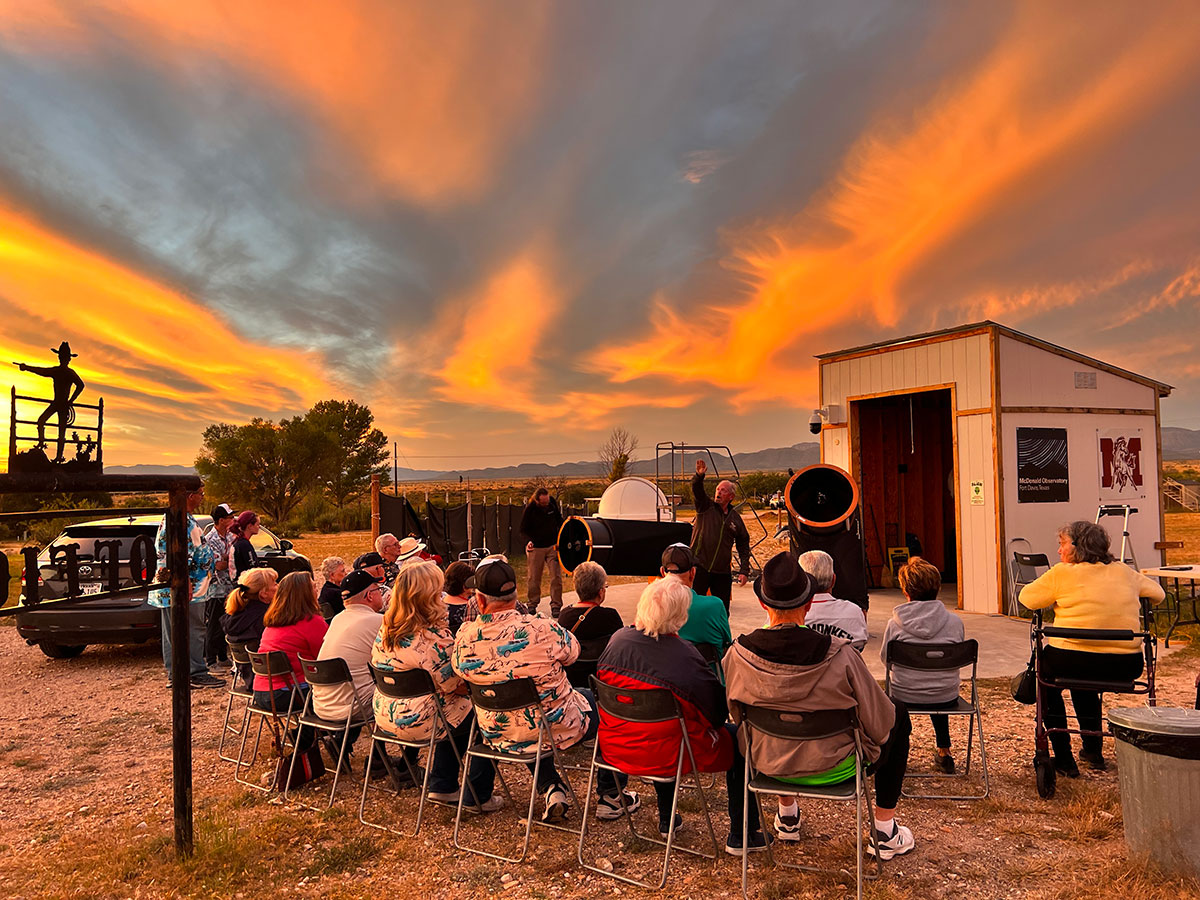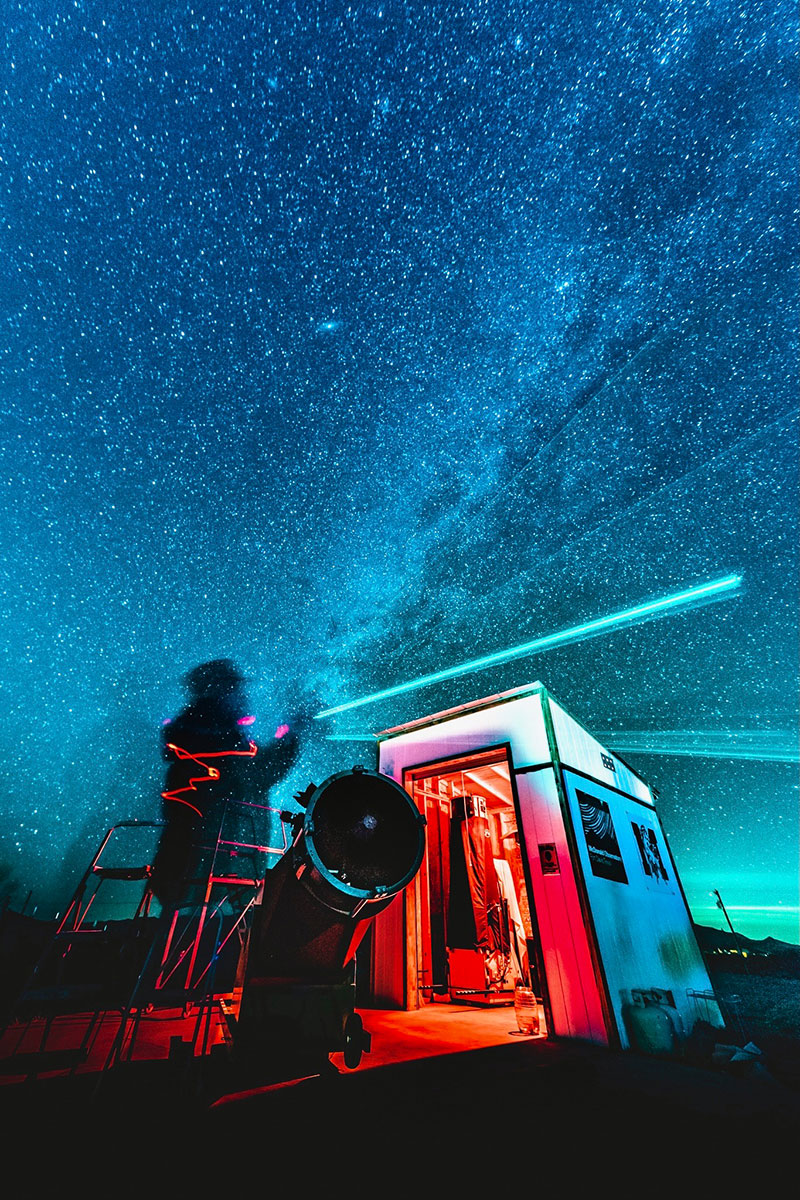
The star parties at Marathon Motel and RV Park, hosted by Bill Ramey, attract visitors from all over West Texas. Photo by Julia Meyer Photography.
After driving solo seven hours from Fort Worth to Marathon in West Texas, I was ready for my head to hit the pillow. But I had traveled out there in search of stars, and it was stars I was determined to see, tired or not. Fortunately, at the Marathon Motel and RV Park, where I was staying, is a man named Bill Ramey, whose enthusiasm for astronomy is enough to give even the most road-weary traveler a jolt.
Established in 1940, the Marathon Motel and RV Park has become an increasingly popular destination for people like me over the past quarter century. That’s thanks in part to its location in the Big Bend region’s Dark Sky Reserve, a nearly 9-million-acre area where light pollution is virtually nonexistent. But the motel has also garnered a stellar reputation among stargazers for its unique Skypark, created by owner Danny Self.
Marathon Star Parties
The Marathon Motel and RV Park is located a half a mile west of Marathon on U.S. Highway 90. Rooms start at $100 a night, and trailer and RV sites start at $35 a night. Tent camping is $15 a night. Go to marathonmotel.com for more information on accommodations and the Skypark. Visit Bill Ramey’s website, darktexasskies.com, for a moon phase calendar with all the details. Admission to the star parties is $10 for adults, and kids under the age of 18 are free.
The Skypark, situated in the middle of the approximately 3-acre property, far from any artificial light source, has multiple observation pads for visitors with their own telescopes and astrophotography equipment. There is also a roll-top observatory housing several remote-viewing scopes and an area set up with a 20-inch and a 24-inch Newtonion reflector telescope, which are brought out for the motel’s open-invite star parties.
Hosting the parties is Ramey, a polymath and all-around nice guy who patiently gives each guest a crash course in celestial mechanics and astrophysics while pointing out the incredible nighttime sights. Parties take place most nights during the month, weather permitting, except when the moon is exceedingly bright. On those nights, the moon’s light washes out many of the more interesting celestial apparitions, like nebulae, the colorful clouds of dust and gas where new stars are formed.

The Skypark, situated in the middle of an approximately 3-acre property, is set up with a 20-inch and a 24-inch Newtonion reflector telescope. Photo by Julia Meyer Photography.
When I visited on a Sunday in June, I was lucky enough to have a clear dark sky, Ramey, and the big 24-inch telescope (which stands about 7 feet tall) all to myself. Over the course of two hours, beginning just after sunset, we explored the cosmos in a way I’d never experienced.
I was fascinated by the detailed views of the moon and its craters and mountains through the scope and spent a good deal of time staring with my jaw hanging open at the Sea of Tranquility, the large basin where the Apollo 11 astronauts first touched down.
Once I’d seen enough of the moon, Ramey directed my attention to a supergiant star, which was so vivid in the telescope’s eyepiece that you could make out a corona of flame emanating from the star’s dark center. As the night went on, we mapped some constellations across the sky, with Ramey taking care to explain how each one changed position in relation to Earth’s rotation. And when I ignorantly pointed to the smear of light in the southern sky and called it the “Milky Way,” Ramey corrected me, explaining that everything we see above us is part of the Milky Way galaxy to which Earth belongs. The bright band of stars and molecular clouds commonly referred to as the Milky Way is actually the Carina-Sagittarius Arm, a relatively small spiral-shaped speck in the immense galaxy we call home, which is somewhere in the neighborhood of 588 trillion miles wide.
These unfathomable galactic figures combined with the road fatigue made my head swim. I finally bid Ramey goodnight and trudged off to my tent. In addition to its lovingly restored classic motel rooms housed in little adobe cabins, the Marathon Motel and RV Park offers campsites with water and electric hookups for trailers and RVs, and there are water-adjacent sites perfect for more primitive camping.
As I lay in the tent that night with the rain fly off, staring up at the stars through the mosquito netting, I tried remembering all that I had learned. I knew much of it wouldn’t stick in my brain for long, but I was nonetheless grateful for the condensed education in astronomy. It opened my eyes to a world above that many never get to see because of the growing scourge of light pollution caused by suburban sprawl. Thankfully there are still places like Marathon where darkness reigns, in a good way.








